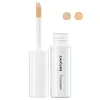What's inside
What's inside
 Key Ingredients
Key Ingredients

 Benefits
Benefits

No benefits
 Concerns
Concerns

 Ingredients Side-by-side
Ingredients Side-by-side

Titanium Dioxide
Cosmetic ColorantCI 77492
Cosmetic ColorantMica
Cosmetic ColorantCyclopentasiloxane
EmollientNeopentyl Glycol Diethylhexanoate
EmollientDiphenylsiloxy Phenyl Trimethicone
Skin ConditioningDipentaerythrityl Tri-Polyhydroxystearate
EmollientDimethicone
EmollientDimethicone Crosspolymer
Emulsion StabilisingButylene Glycol
HumectantGlycerin
HumectantTrehalose
HumectantSodium Hyaluronate
HumectantMethyl Methacrylate Crosspolymer
Trimethylsiloxysilicate
EmollientEthylhexyl Methoxycinnamate
UV AbsorberLauryl PEG-9 Polydimethylsiloxyethyl Dimethicone
Skin ConditioningPolyglyceryl-2 Diisostearate
EmulsifyingPEG-10 Dimethicone
Skin ConditioningDisteardimonium Hectorite
StabilisingMethylparaben
PreservativePropylparaben
PreservativeSodium Stearoyl Glutamate
CleansingHydrogen Dimethicone
Potassium Hydroxide
BufferingTriethoxycaprylylsilane
Zinc Chloride
AntimicrobialBHT
AntioxidantTocopherol
AntioxidantWater
Skin ConditioningTitanium Dioxide, CI 77492, Mica, Cyclopentasiloxane, Neopentyl Glycol Diethylhexanoate, Diphenylsiloxy Phenyl Trimethicone, Dipentaerythrityl Tri-Polyhydroxystearate, Dimethicone, Dimethicone Crosspolymer, Butylene Glycol, Glycerin, Trehalose, Sodium Hyaluronate, Methyl Methacrylate Crosspolymer, Trimethylsiloxysilicate, Ethylhexyl Methoxycinnamate, Lauryl PEG-9 Polydimethylsiloxyethyl Dimethicone, Polyglyceryl-2 Diisostearate, PEG-10 Dimethicone, Disteardimonium Hectorite, Methylparaben, Propylparaben, Sodium Stearoyl Glutamate, Hydrogen Dimethicone, Potassium Hydroxide, Triethoxycaprylylsilane, Zinc Chloride, BHT, Tocopherol, Water
Cyclopentasiloxane
EmollientDimethicone
EmollientIsododecane
EmollientTrimethylpentanediol/Adipic Acid/Glycerin Crosspolymer
Skin ConditioningDimethicone Crosspolymer
Emulsion StabilisingPolymethylsilsesquioxane
Methyl Methacrylate Crosspolymer
Disodium Stearoyl Glutamate
CleansingSilica Silylate
EmollientPhenoxyethanol
PreservativeAluminum Hydroxide
EmollientVinyl Dimethicone/Methicone Silsesquioxane Crosspolymer
Methylparaben
PreservativeBHT
AntioxidantEthylparaben
PreservativePropylparaben
PreservativeIsobutylparaben
AntimicrobialButylparaben
MaskingCI 77891
Cosmetic ColorantCI 77499
Cosmetic ColorantCI 77492
Cosmetic ColorantCI 77491
Cosmetic ColorantCI 77163
Cosmetic ColorantCyclopentasiloxane, Dimethicone, Isododecane, Trimethylpentanediol/Adipic Acid/Glycerin Crosspolymer, Dimethicone Crosspolymer, Polymethylsilsesquioxane, Methyl Methacrylate Crosspolymer, Disodium Stearoyl Glutamate, Silica Silylate, Phenoxyethanol, Aluminum Hydroxide, Vinyl Dimethicone/Methicone Silsesquioxane Crosspolymer, Methylparaben, BHT, Ethylparaben, Propylparaben, Isobutylparaben, Butylparaben, CI 77891, CI 77499, CI 77492, CI 77491, CI 77163
Ingredients Explained
These ingredients are found in both products.
Ingredients higher up in an ingredient list are typically present in a larger amount.
BHT is a synthetic antioxidant and preservative.
As an antioxidant, it helps your body fight off free-radicals. Free-radicals are molecules that may damage your skin cells.
As a preservative, it is used to stabilize products and prevent them from degrading. Specifically, BHT prevents degradation from oxidation.
The concerns related to BHT come from oral studies; this ingredient is currently allowed for use by both the FDA and EU.
However, it was recently restricted for use in the UK as of April 2024.
Learn more about BHTCi 77492 is also hydrated iron III oxide. It's sole purpose is to give a yellow hue to products.
Iron III oxides are classified as inorganic chemicals for coloring.
Synthetically created Ci 77492 is considered safer than those naturally found. This is because the synthetically created version may contain less impurities. Iron oxides are generally non-toxic and non-allergenic.
Learn more about CI 77492Cyclopentasiloxane, or D5, is a silicone used to improve texture of products and trap moisture.
D5 is considered lightweight and volatile. Volatile means it evaporates quickly after application. Once evaporated, D5 leaves a thin barrier that helps keep skin hydrated.
It is also an emollient. Emollients help soften the skin and prevent water loss. Silicones create a silky texture in products. D5 helps other ingredients become more spreadable.
Studies show D5 is safe to use in skincare products. We recommend speaking with a skincare professional if you have concerns.
Learn more about CyclopentasiloxaneDimethicone is a type of synthetic silicone created from natural materials such as quartz.
What it does:
Dimethicone comes in different viscosities:
Depending on the viscosity, dimethicone has different properties.
Ingredients lists don't always show which type is used, so we recommend reaching out to the brand if you have questions about the viscosity.
This ingredient is unlikely to cause irritation because it does not get absorbed into skin. However, people with silicone allergies should be careful about using this ingredient.
Note: Dimethicone may contribute to pilling. This is because it is not oil or water soluble, so pilling may occur when layered with products. When mixed with heavy oils in a formula, the outcome is also quite greasy.
Learn more about DimethiconeDimethicone Crosspolymer is a silicone created by modifying dimethicone with hydrocarbon side chains. Due to its large size, it does not penetrate skin. It is considered non-occlusive.
Dimethicone Crosspolymer is used to stabilize and thicken products. It also helps give products a silky feel.
This ingredient comes as a powder made up of small, porous, microbeads. It is used to add a silky feel to products and also helps absorb oil.
Methylparaben is a preservative and is a paraben. It is used to prevent the growth of fungus, mold, and other harmful bacteria. Parabens are chemicals used as preservatives in both cosmetics and food.
Methylparaben can be synthetically created. It can also be found naturally in some fruits, such as blueberries.
Oftentimes, Methylparaben is combined with other parabens to help increase the shelf life.
The safety of Methylparaben is currently being studied. While ongoing studies are looking into the safety of parabens, the results have been very mixed. Some studies have not found Methylparaben to be harmful.
Learn more about MethylparabenPropylparaben is a preservative and is a paraben with antifungal and antimicrobial properties.
This ingredient can be naturally found in plants and insects, but most of it is synthetically manufactured for human use. In cosmetics, it is usually created by reacting para-aminobenzoic acid and propanol (an alcohol).
You can usually find this ingredient in water-based products.
Parabens have come under controversy due to the claim they are hormone disruptors. Studies show conflicting results. We recommend speaking with a professional if you have any concerns.
Propylparaben is commonly found in food, medicine, and cosmetics.
Learn more about Propylparaben